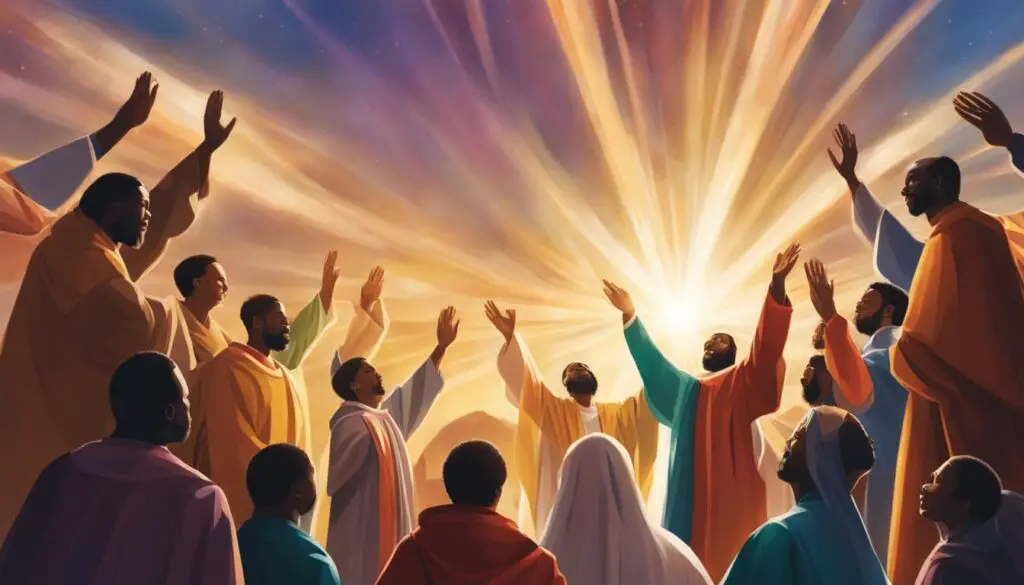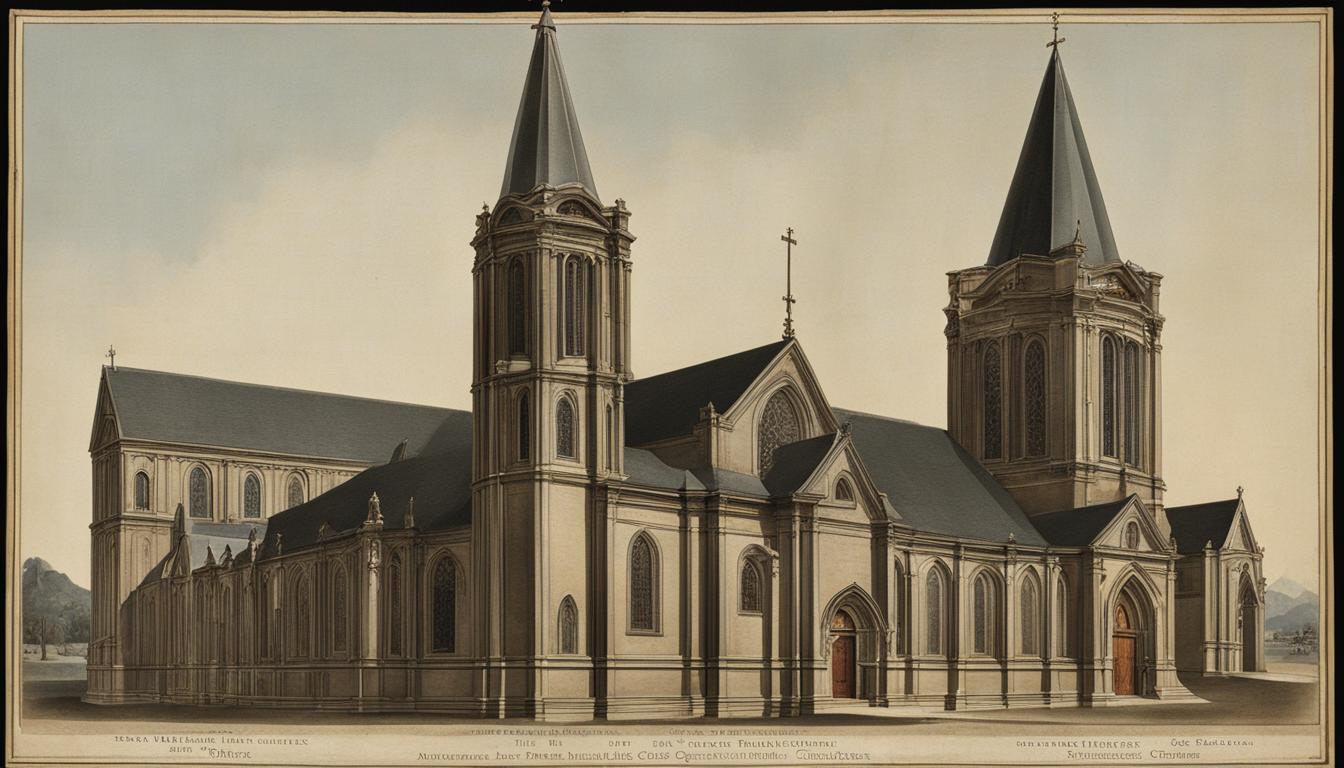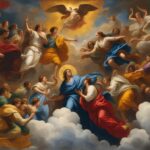The Body of Christ is more than just an abstract concept in Christianity. It represents the unity and purpose of the church, symbolizing the collective group of believers who follow Jesus Christ. Within the context of the Body of Christ, believers find spiritual growth and Christian community that shape their lives and faith.
At its core, the Body of Christ is a community of individuals who are united in their belief in Jesus as their Savior and Lord. This unity fosters an environment where believers can grow spiritually, learn from one another, and support each other in their walk with Christ. It is in this collective body that the true essence of the Christian faith comes to life.
The concept of the Body of Christ traces its origins back to the biblical teachings of the Apostle Paul. He used this analogy to describe the interconnectedness and interdependence of believers, with Jesus as the head of the body. This understanding emphasizes the importance of every believer, as each member contributes their unique gifts and talents to the growth and edification of the church.
Within the Body of Christ, there are shared beliefs and doctrines that guide its members, promoting unity and understanding. These teachings revolve around the acceptance of Jesus Christ as the Son of God and the Savior of humanity. They emphasize the need for faith, repentance, and obedience to God’s commandments, as well as the pursuit of spiritual growth and righteous living.
Sacraments and rituals play a vital role within the Body of Christ, deepening believers’ spiritual experiences and expressions of faith. Baptism represents the believer’s identification with Christ’s death, burial, and resurrection. Communion, on the other hand, signifies the sharing of Christ’s body and blood through the bread and wine. These meaningful practices strengthen the bond among believers and their connection to Christ.
Leadership and clergy within the Body of Christ guide, support, and nurture the spiritual growth of the church. Pastors, priests, ministers, and other clergy members provide pastoral care, teach God’s Word, and facilitate worship and fellowship. Their role is to equip believers for ministry and to foster unity within the Body of Christ.
Worship is a central practice within the Body of Christ, as believers express their reverence and devotion to God. Through singing hymns, praying, studying the Bible, and participating in corporate gatherings, believers draw closer to God and experience His presence. Worship not only strengthens the individual’s faith but also fosters a sense of unity and community within the Body of Christ.
The Bible serves as the sacred text of the Body of Christ, providing the foundation for its beliefs and practices. It is considered the inspired Word of God and is valued as the ultimate source of wisdom, truth, and guidance. The study and application of the Bible contribute to the spiritual growth and understanding of believers, leading them to live out their faith in practical ways.
Within the Body of Christ, there are various denominations and sects with distinct interpretations and practices. These differences arise from cultural, historical, and theological influences. Despite these variations, the Body of Christ recognizes the common bond of faith in Jesus Christ and seeks unity, cooperation, and collaboration in spreading the Gospel and serving the community.
Community and outreach are essential aspects of the Body of Christ. Believers are called to extend God’s love, compassion, and salvation to others through acts of service, evangelism, and community engagement. By actively living out their faith, the Body of Christ impacts society and positively influences the world around them.
Key Takeaways:
- The Body of Christ symbolizes the unity and purpose of the church.
- Believers find spiritual growth and Christian community within the Body of Christ.
- The concept of the Body of Christ originated from the teachings of the Apostle Paul.
- Sacraments and rituals deepen believers’ spiritual experiences.
- Leadership and clergy play a vital role in nurturing the church.
History and Origins of the Body of Christ
The concept of the Body of Christ has its origins in the biblical teachings of the Apostle Paul. In his epistles, Paul used the analogy of the body to describe the interconnectedness and unity of believers with Jesus as the head. This idea has been passed down through generations and has become a foundational belief in many Christian denominations.
Paul’s teachings on the Body of Christ emphasized the spiritual connection and shared identity of all believers in the church. Just as the human body has different parts that work together harmoniously, so too does the Body of Christ consist of diverse individuals with unique gifts and roles, united in their faith and purpose.
This concept of the Body of Christ resonates with believers, as it illustrates the intimate relationship between Christ and his followers. It symbolizes the spiritual bond and the mutual dependence that exists within the Christian community. Every believer, regardless of their background or position, is part of this greater whole, with Jesus as the head and source of life.
Key Historical Milestones
Throughout history, the concept of the Body of Christ has influenced the understanding of Christian identity and the nature of the church. Here are a few key milestones in its development:
| Time Period | Event |
|---|---|
| 1st century AD | Paul’s letters to the early Christian communities explicitly mention the Body of Christ, laying the foundation for its theological significance. |
| 4th century AD | The Council of Nicaea solidifies the belief in the divinity of Christ, affirming his position as the head of the Body of Christ. |
| 16th century AD | The Protestant Reformation challenges traditional church structures and emphasizes the priesthood of all believers, highlighting the role of every individual in the Body of Christ. |
| 20th century AD | The ecumenical movement fosters dialogue and cooperation among different Christian denominations, promoting a sense of unity within the Body of Christ. |
The history of the Body of Christ reflects the growth and evolution of Christian thought and practice over time. It continues to be a fundamental concept that unites believers worldwide, transcending denominational and cultural boundaries.

Beliefs and Doctrines of the Body of Christ
The Body of Christ encompasses various beliefs and doctrines that guide the actions and values of its members. Central to this belief is the acceptance of Jesus Christ as the Son of God and the Savior of humanity. The Body of Christ emphasizes the importance of faith, repentance, and obedience to God’s commandments. It also teaches the need for spiritual growth and the importance of living a righteous and holy life.
“And without faith it is impossible to please God, because anyone who comes to him must believe that he exists and that he rewards those who earnestly seek him.” – Hebrews 11:6
In the Body of Christ, believers understand that faith is the foundation of their relationship with God. It is through faith that they approach God, receive salvation, and experience spiritual transformation. This belief in the power of faith drives them to trust in God’s promises and live by His Word.
Repentance is another essential belief within the Body of Christ. It involves acknowledging and turning away from sin, seeking forgiveness, and striving to live a life that aligns with God’s will. Through repentance, believers experience a renewed relationship with God and receive His forgiveness and grace.
Obedience to God’s commandments is emphasized as a sign of genuine faith and love for God. The Body of Christ teaches that obedience is not a burden but a joyful response to God’s goodness and wisdom. It is through obedience that believers express their devotion to God and demonstrate their commitment to following Christ’s example.
A righteous and holy life is seen as the natural outgrowth of faith, repentance, and obedience. The Body of Christ encourages believers to pursue moral integrity, display love and compassion, and live in a way that reflects the character of Christ. This pursuit of righteousness is viewed as a continual process of transformation and sanctification.
By embodying these core beliefs and doctrines, members of the Body of Christ seek to honor God, grow in their spiritual walk, and contribute to the advancement of His kingdom.
Core Beliefs and Doctrines of the Body of Christ
| Belief/Doctrine | Description |
|---|---|
| Faith | The belief in the existence of God and trust in His promises |
| Repentance | The turning away from sin and seeking forgiveness |
| Obedience | The submission to God’s commandments and living according to His Word |
| Righteousness | The pursuit of moral integrity and living in a way that reflects Christ’s character |

The core beliefs and doctrines of the Body of Christ form the foundation of its spiritual journey. These principles shape the values, actions, and worldview of believers as they seek to live out their faith and fulfill God’s purposes in the world.
Sacraments and Rituals of the Body of Christ
The Body of Christ, as a manifestation of Christian faith, participates in sacraments and rituals that hold immense spiritual significance. These practices serve as tangible expressions of faith and provide believers with opportunities to connect with God on a profound level.
Baptism
One of the primary sacraments within the Body of Christ is baptism. This sacred ritual symbolizes the believer’s identification with the death, burial, and resurrection of Jesus Christ. Through immersion in water or the application of water, individuals publicly declare their faith and commitment to follow Christ. Baptism signifies the cleansing of sins and the initiation into the Body of Christ as a new creation.
Communion
Another significant sacrament is communion, also known as the Lord’s Supper or the Eucharist. During this ritual, believers partake in the sharing of bread and wine, which symbolize the body and blood of Jesus Christ. Communion serves as a reminder of Christ’s sacrifice on the cross and the ongoing fellowship between believers and their Savior. It represents unity within the Body of Christ and the spiritual nourishment that comes from a deep relationship with Jesus.
Other Rituals
In addition to baptism and communion, there are various other rituals and practices that differ among different Christian denominations. These rituals often involve acts of worship, prayer, and service to others. Examples include the anointing of the sick, confirmation, marriage, and ordination. These rituals provide opportunities for believers to express their devotion, seek God’s guidance, and receive spiritual blessings.

The sacraments and rituals of the Body of Christ serve as channels through which believers can experience the presence and grace of God. They deepen the spiritual connection within the Christian community and offer believers a tangible way to express their faith and commitment to Christ.
| Sacraments | Key Elements |
|---|---|
| Baptism | Identification with Christ’s death, burial, and resurrection |
| Communion | Sharing of Christ’s body and blood through bread and wine |
| Anointing of the Sick | Prayer and anointing for healing and spiritual support |
| Confirmation | Reaffirmation of faith and receiving the Holy Spirit |
| Marriage | Union between a man and a woman before God |
| Ordination | Setting apart individuals for leadership and ministry |
Leadership and Clergy within the Body of Christ
The Body of Christ is blessed with dedicated individuals who serve as leaders and clergy members, guiding the spiritual journey of believers and nurturing the Christian community. These leaders, including pastors, priests, ministers, and other clergy, play a vital role in fostering the growth and unity of the Body of Christ.
Their primary responsibility is to provide guidance, spiritual nourishment, and pastoral care to the members of the church. Through their wisdom, knowledge, and commitment to God’s Word, they equip believers for the work of ministry and empower them to fulfill their calling in the Body of Christ. With reverence and humility, they shepherd the flock, helping each individual to find their purpose and reach their fullest potential in Christ.
One crucial aspect of their role is to promote unity within the Body of Christ. They facilitate a sense of belonging and togetherness, ensuring that every member feels valued and embraced in the Christian community. By fostering love, respect, and understanding among believers, they create an environment where the Body of Christ can thrive and fulfill its mission in the world.
In addition to promoting unity, clergy members also facilitate the worship and teaching of God’s Word. They lead congregations in meaningful worship experiences, creating an atmosphere where believers can come before God, express their devotion, and encounter His presence. Furthermore, they expound on the Scriptures, helping believers gain deeper insights into God’s truth and guiding them in the application of biblical principles in their daily lives.
The role of leadership and clergy within the Body of Christ is as diverse as the individuals who serve in these positions. They may possess different gifts and talents, but they all share a common commitment to serving God and His people. Their selfless dedication and Christ-like example inspire the community to grow in faith, love, and compassion, reflecting the very image of Jesus in their lives.

| Qualities of Leadership and Clergy in the Body of Christ |
|---|
| 1. Anointing and Calling from God |
| 2. Humility and Servant-heartedness |
| 3. Knowledge and Understanding of Scripture |
| 4. Wisdom and Discernment |
| 5. Compassion and Empathy |
| 6. Strong Communication and Leadership Skills |
| 7. Commitment to Personal Growth and Development |
Worship Practices within the Body of Christ
Worship is a central aspect of the Body of Christ, encompassing a range of practices that allow believers to express reverence, adoration, and devotion to God. It is through worship that Christians connect with the divine and experience a deepening of their spiritual relationship.
One of the primary forms of worship within the Body of Christ is the singing of hymns and worship songs. These melodic expressions of faith not only uplift the hearts of believers but also serve as a means of collective praise and adoration. The words and melodies resonate within the souls of worshipers, creating a space for personal and communal connection with God.
Prayer is another vital element of worship. Through prayer, believers communicate with God, seeking guidance, expressing gratitude, and surrendering their burdens and desires. Whether offered silently or aloud, individually or collectively, prayer is a foundational practice that allows the Body of Christ to commune with the divine.
The reading and studying of the Bible also form an integral part of worship. The sacred texts of the Body of Christ hold great significance as they contain the teachings, stories, and wisdom that guide believers in their faith journey. Through the study of Scripture, individuals gain a deeper understanding of God’s truth and are equipped to live out their faith in daily life.
Worship within the Body of Christ is not confined to personal or private practices. Corporate gatherings such as church services and fellowship groups provide believers with opportunities to worship together, strengthen their sense of community, and encourage one another in their spiritual walk.

These gatherings often include elements such as collective prayer, testimonies, and the proclamation and teaching of God’s Word. They serve as important junctures where believers come together to celebrate their shared faith, experience the presence of God, and grow in their understanding of Him.
Ultimately, worship within the Body of Christ is not limited to specific practices but encompasses a lifestyle of devotion and surrender to God. It extends beyond the walls of a church building and permeates every aspect of a believer’s life. Through worship, individuals are transformed and renewed, drawing closer to God and experiencing His love and grace in profound ways.
Sacred Texts of the Body of Christ
The Body of Christ finds its guidance and inspiration from sacred texts that hold profound significance in shaping its beliefs and practices. At the center of these sacred texts is the Bible, considered the inspired Word of God. With its rich tapestry of teachings, stories, and wisdom, the Bible serves as a compass for believers on their spiritual journey.
Through the pages of the Bible, the Body of Christ discovers timeless truths and divine revelations that illuminate the path towards a stronger faith and a deeper understanding of God’s will. From the inspiring narratives of creation and redemption to the profound teachings of Jesus and the apostles, the sacred texts of the Bible invite believers to engage in a lifelong quest for spiritual growth and a closer relationship with God.
While the Bible forms the cornerstone of the Body of Christ’s sacred texts, it is important to recognize that different Christian denominations may have additional texts or interpretations that they consider sacred. These texts, whether they be ancient writings or more contemporary works, often serve to provide nuanced perspectives on faith and theology, enriching the overall understanding of the Body of Christ.
Ultimately, the Body of Christ values the study and application of these sacred texts as a means of deepening their connection with God and fostering a life of faith, love, and service. As believers engage with these texts, they discover not only answers to life’s profound questions but also find themselves drawn into a transformative encounter with the Divine.
Denominations and Sects within the Body of Christ
The Body of Christ, consisting of believers who follow Jesus Christ, encompasses various denominations and sects with distinct interpretations of Scripture, as well as unique beliefs and practices. These differences arise from a combination of cultural, historical, and theological influences. However, despite these variations, the Body of Christ emphasizes the common bond of faith in Jesus Christ and strives for unity and cooperation in spreading the Gospel and serving the community.
While there are numerous denominations and sects within the Body of Christ, some of the prominent ones include:
- Catholicism: With its roots in the early Christian Church, Catholicism is one of the oldest and largest Christian denominations. It places a strong emphasis on liturgical worship, sacraments, and the authority of the Pope.
- Protestantism: Stemming from the Protestant Reformation in the 16th century, Protestantism comprises various denominations, including Lutheranism, Anglicanism, Methodism, and Presbyterianism. Protestant traditions emphasize the authority of Scripture, justification by faith alone, and the priesthood of all believers.
- Orthodox Christianity: Originating in the Eastern Roman Empire, Orthodoxy is characterized by its adherence to ancient traditions, sacraments, and the authority of the Patriarchs. It is divided into several autonomous churches, such as the Greek Orthodox Church, Russian Orthodox Church, and Coptic Orthodox Church.
These are just a few examples of the rich diversity within the Body of Christ. Each denomination and sect offers unique perspectives on theology, worship, and spirituality, catering to the needs and preferences of its members.
Community and Outreach of the Body of Christ
The Body of Christ not only serves as a place for its members to grow spiritually and foster fellowship, but it also has a vital role in reaching out to others. With a deep commitment to extending God’s love, compassion, and salvation to the world, the Body of Christ actively engages in acts of service, evangelism, and community outreach.
Recognizing the importance of living out its faith in practical ways, the Body of Christ seeks to make a positive impact on society and address the needs of those around them. With a heart for community, believers come together to serve the disadvantaged, offer aid to the marginalized, and support various charitable initiatives.
Through their acts of service, the Body of Christ showcases the transformative power of God’s love. Whether it is feeding the hungry, providing shelter for the homeless, or visiting the sick and imprisoned, these tangible expressions of care and compassion bring hope and restoration to individuals and communities in need.
Moreover, the Body of Christ engages in evangelism, sharing the message of salvation with those who have yet to experience the love of Christ. Drawing from its belief in the transformative power of the Gospel, the Body of Christ proclaims the good news and invites others to discover the life-changing relationship with Jesus. By actively inviting others into the Body of Christ, believers aim to create a diverse and inclusive community that reflects the love and unity found in Christ.
FAQ
What is the Body of Christ?
The Body of Christ is a concept in Christianity that refers to the unity and purpose of the church. It symbolizes the collective group of believers who follow Jesus Christ and are united in their faith.
Where did the concept of the Body of Christ originate?
The concept of the Body of Christ originated in the biblical teachings of the Apostle Paul, who used the analogy to describe the interconnectedness and unity of believers with Jesus as the head.
What are the beliefs and doctrines of the Body of Christ?
Central to the beliefs and doctrines of the Body of Christ is the acceptance of Jesus Christ as the Son of God and the Savior of humanity. It emphasizes the importance of faith, repentance, obedience to God’s commandments, and the need for spiritual growth.
What are the sacraments and rituals of the Body of Christ?
The sacraments and rituals of the Body of Christ include baptism, which symbolizes the believer’s identification with Christ’s death, burial, and resurrection, and communion, which represents the sharing of Christ’s body and blood. Other rituals may vary among different Christian denominations.
Who are the leaders within the Body of Christ?
The Body of Christ is led by individuals who serve as pastors, priests, ministers, or other clergy members. These leaders provide guidance, spiritual nourishment, and pastoral care to the members of the church.
What are the worship practices within the Body of Christ?
Worship practices within the Body of Christ may include singing hymns and worship songs, praying, reading and studying the Bible, and participating in corporate gatherings such as church services and fellowship groups.
What are the sacred texts of the Body of Christ?
The sacred texts of the Body of Christ include the Bible, which is considered the inspired Word of God. Different Christian denominations may have additional texts or interpretations that they consider sacred.
How do denominations and sects fit within the Body of Christ?
The Body of Christ consists of various denominations and sects that may have different interpretations of Scripture and distinct beliefs and practices. However, despite these variations, the Body of Christ recognizes the common bond of faith in Jesus Christ and strives for unity and cooperation in spreading the Gospel and serving the community.
What is the community and outreach of the Body of Christ?
The Body of Christ exists not only for the spiritual growth and fellowship of its members but also for the purpose of reaching out to others. It seeks to extend God’s love, compassion, and salvation to the world through acts of service, evangelism, and community engagement.
















